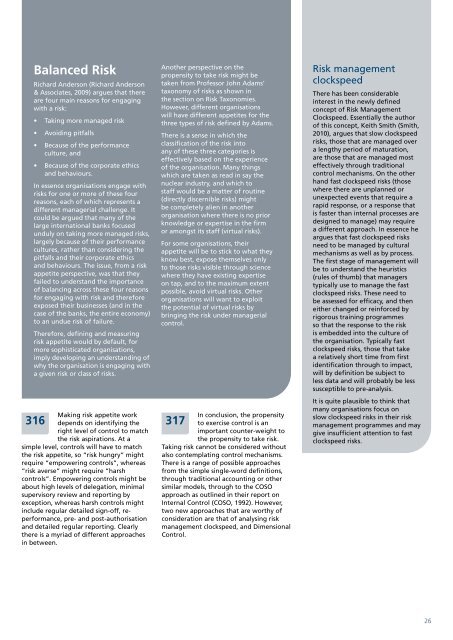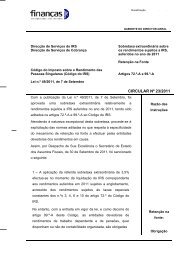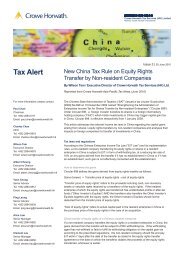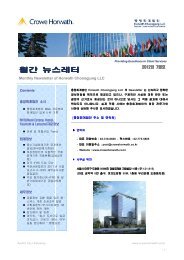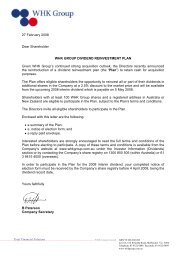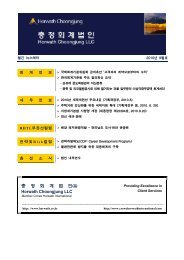Guidance Paper - The Institute of Risk Management
Guidance Paper - The Institute of Risk Management
Guidance Paper - The Institute of Risk Management
Create successful ePaper yourself
Turn your PDF publications into a flip-book with our unique Google optimized e-Paper software.
Balanced <strong>Risk</strong><br />
Richard Anderson (Richard Anderson<br />
& Associates, 2009) argues that there<br />
are four main reasons for engaging<br />
with a risk:<br />
• Taking more managed risk<br />
• Avoiding pitfalls<br />
• Because <strong>of</strong> the performance<br />
culture, and<br />
• Because <strong>of</strong> the corporate ethics<br />
and behaviours.<br />
In essence organisations engage with<br />
risks for one or more <strong>of</strong> these four<br />
reasons, each <strong>of</strong> which represents a<br />
different managerial challenge. It<br />
could be argued that many <strong>of</strong> the<br />
large international banks focused<br />
unduly on taking more managed risks,<br />
largely because <strong>of</strong> their performance<br />
cultures, rather than considering the<br />
pitfalls and their corporate ethics<br />
and behaviours. <strong>The</strong> issue, from a risk<br />
appetite perspective, was that they<br />
failed to understand the importance<br />
<strong>of</strong> balancing across these four reasons<br />
for engaging with risk and therefore<br />
exposed their businesses (and in the<br />
case <strong>of</strong> the banks, the entire economy)<br />
to an undue risk <strong>of</strong> failure.<br />
<strong>The</strong>refore, defining and measuring<br />
risk appetite would by default, for<br />
more sophisticated organisations,<br />
imply developing an understanding <strong>of</strong><br />
why the organisation is engaging with<br />
a given risk or class <strong>of</strong> risks.<br />
Making risk appetite work<br />
316 depends on identifying the<br />
right level <strong>of</strong> control to match<br />
the risk aspirations. At a<br />
simple level, controls will have to match<br />
the risk appetite, so “risk hungry” might<br />
require “empowering controls”, whereas<br />
“risk averse” might require “harsh<br />
controls”. Empowering controls might be<br />
about high levels <strong>of</strong> delegation, minimal<br />
supervisory review and reporting by<br />
exception, whereas harsh controls might<br />
include regular detailed sign-<strong>of</strong>f, reperformance,<br />
pre- and post-authorisation<br />
and detailed regular reporting. Clearly<br />
there is a myriad <strong>of</strong> different approaches<br />
in between.<br />
Another perspective on the<br />
propensity to take risk might be<br />
taken from Pr<strong>of</strong>essor John Adams’<br />
taxonomy <strong>of</strong> risks as shown in<br />
the section on <strong>Risk</strong> Taxonomies.<br />
However, different organisations<br />
will have different appetites for the<br />
three types <strong>of</strong> risk defined by Adams.<br />
<strong>The</strong>re is a sense in which the<br />
classification <strong>of</strong> the risk into<br />
any <strong>of</strong> these three categories is<br />
effectively based on the experience<br />
<strong>of</strong> the organisation. Many things<br />
which are taken as read in say the<br />
nuclear industry, and which to<br />
staff would be a matter <strong>of</strong> routine<br />
(directly discernible risks) might<br />
be completely alien in another<br />
organisation where there is no prior<br />
knowledge or expertise in the firm<br />
or amongst its staff (virtual risks).<br />
For some organisations, their<br />
appetite will be to stick to what they<br />
know best, expose themselves only<br />
to those risks visible through science<br />
where they have existing expertise<br />
on tap, and to the maximum extent<br />
possible, avoid virtual risks. Other<br />
organisations will want to exploit<br />
the potential <strong>of</strong> virtual risks by<br />
bringing the risk under managerial<br />
control.<br />
In conclusion, the propensity<br />
317 to exercise control is an<br />
important counter-weight to<br />
the propensity to take risk.<br />
Taking risk cannot be considered without<br />
also contemplating control mechanisms.<br />
<strong>The</strong>re is a range <strong>of</strong> possible approaches<br />
from the simple single-word definitions,<br />
through traditional accounting or other<br />
similar models, through to the COSO<br />
approach as outlined in their report on<br />
Internal Control (COSO, 1992). However,<br />
two new approaches that are worthy <strong>of</strong><br />
consideration are that <strong>of</strong> analysing risk<br />
management clockspeed, and Dimensional<br />
Control.<br />
<strong>Risk</strong> management<br />
clockspeed<br />
<strong>The</strong>re has been considerable<br />
interest in the newly defined<br />
concept <strong>of</strong> <strong>Risk</strong> <strong>Management</strong><br />
Clockspeed. Essentially the author<br />
<strong>of</strong> this concept, Keith Smith (Smith,<br />
2010), argues that slow clockspeed<br />
risks, those that are managed over<br />
a lengthy period <strong>of</strong> maturation,<br />
are those that are managed most<br />
effectively through traditional<br />
control mechanisms. On the other<br />
hand fast clockspeed risks (those<br />
where there are unplanned or<br />
unexpected events that require a<br />
rapid response, or a response that<br />
is faster than internal processes are<br />
designed to manage) may require<br />
a different approach. In essence he<br />
argues that fast clockspeed risks<br />
need to be managed by cultural<br />
mechanisms as well as by process.<br />
<strong>The</strong> first stage <strong>of</strong> management will<br />
be to understand the heuristics<br />
(rules <strong>of</strong> thumb) that managers<br />
typically use to manage the fast<br />
clockspeed risks. <strong>The</strong>se need to<br />
be assessed for efficacy, and then<br />
either changed or reinforced by<br />
rigorous training programmes<br />
so that the response to the risk<br />
is embedded into the culture <strong>of</strong><br />
the organisation. Typically fast<br />
clockspeed risks, those that take<br />
a relatively short time from first<br />
identification through to impact,<br />
will by definition be subject to<br />
less data and will probably be less<br />
susceptible to pre-analysis.<br />
It is quite plausible to think that<br />
many organisations focus on<br />
slow clockspeed risks in their risk<br />
management programmes and may<br />
give insufficient attention to fast<br />
clockspeed risks.<br />
26


